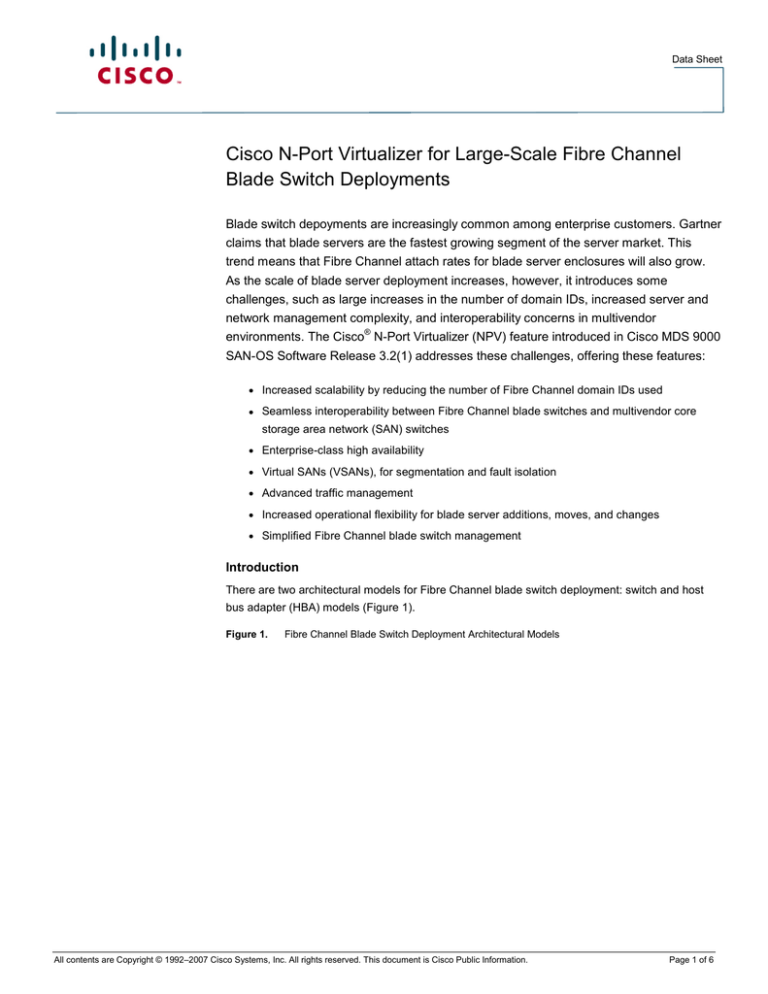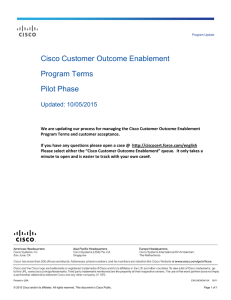
Data Sheet
Cisco N-Port Virtualizer for Large-Scale Fibre Channel
Blade Switch Deployments
Blade switch depoyments are increasingly common among enterprise customers. Gartner
claims that blade servers are the fastest growing segment of the server market. This
trend means that Fibre Channel attach rates for blade server enclosures will also grow.
As the scale of blade server deployment increases, however, it introduces some
challenges, such as large increases in the number of domain IDs, increased server and
network management complexity, and interoperability concerns in multivendor
®
environments. The Cisco N-Port Virtualizer (NPV) feature introduced in Cisco MDS 9000
SAN-OS Software Release 3.2(1) addresses these challenges, offering these features:
●
Increased scalability by reducing the number of Fibre Channel domain IDs used
●
Seamless interoperability between Fibre Channel blade switches and multivendor core
storage area network (SAN) switches
●
Enterprise-class high availability
●
Virtual SANs (VSANs), for segmentation and fault isolation
●
Advanced traffic management
●
Increased operational flexibility for blade server additions, moves, and changes
●
Simplified Fibre Channel blade switch management
Introduction
There are two architectural models for Fibre Channel blade switch deployment: switch and host
bus adapter (HBA) models (Figure 1).
Figure 1.
Fibre Channel Blade Switch Deployment Architectural Models
All contents are Copyright © 1992–2007 Cisco Systems, Inc. All rights reserved. This document is Cisco Public Information.
Page 1 of 6
Data Sheet
In the switch model, the Fibre Channel blade switch connects to the core SAN through an E port.
In the HBA model, the Fibre Channel blade switch connects to the core SAN through an N port
using N-port ID virtualization (NPIV) technology.
Key Features and Benefits of NPV
●
Enhanced scalability with reduced domain ID use: One of the primary challenges in largescale blade server deployments is the number of Fibre Channel domain IDs that are
required. Each Fibre Channel blade switch in a blade server uses one Fibre Channel
domain ID and provides Fibre Channel connectivity for up to 16 blade servers. For
example, a 1000–blade server deployment will require up to 60 Fibre Channel blade
switches, which translates to 60 Fibre Channel domain IDs. This number becomes a
deployment challenge because storage OSMs(Original Storage Manufacturers) place an
upper limit on the number of Fibre Channel domain IDs in a SAN. This number is typically
less than 40 even though the theoretical limit is 239. Cisco NPV addresses this challenge.
With Cisco NPV, the Fibre Channel blade switch behaves like an HBA, so it does not use a
Fibre Channel domain ID. Instead, it gets a Fibre Channel ID (FC-ID) for the blade servers
from the core SAN. Therefore, a 1000–blade server deployment will use only two or so
Fibre Channel doman IDs.
●
Seamless interoperability in multivendor environements: The existing switch-switch
interoperability between multivendor SANs based on E-port connectivity requires
configuration of special interopability modes and has to be managed carefully in an ongoing
process. Cisco NPV addresses this challenge. With Cisco NPV, the Fibre Channel switch
behaves like an HBA, so it provides transparent interoperability in multivendor
environemnts. Thus, interoperability between Fibre Channel blade switches with Cisco NPV
enabled and the core SAN is no different than interoperability today between a server
connected to a SAN using N-port–to–F-port connectivity.
●
Enterprise-class high availability: Cisco NPV in conjunction with inherent Cisco MDS 9000
SAN-OS Software capabilities offers enterprise-class high availability for blade server
deployments. Cisco MDS 9000 SAN-OS Software supports Cisco In-Service Software
Upgrade (ISSU), or nondisruptive software upgrade. With dual HBAs in the server, dual
All contents are Copyright © 1992–2007 Cisco Systems, Inc. All rights reserved. This document is Cisco Public Information.
Page 2 of 6
Data Sheet
homing of servers to fabric switches and a two-core design eliminates any single point of
failure. HBA failure, fabric switch failure, or link failure is handled without any loss of
connectivity (Figure 2).
Figure 2.
●
High Availability
VSANs for segmentation and fault isolation: VSAN, an industry standard for fabric
virtualization capabilities, allows more efficient storage network use through creation of
hardware-based isolated environments within a single physical SAN fabric or switch. Up to
16 VSANs are supported per switch. Each VSAN supports role-based access control
(RBAC), allows separate configuration and separate fabric services, and operates as a
separate SAN. In the example in Figure 3, two VSANs are created and traffic is segregated.
Each blade server can have an independent VSAN or a group of servers can be on one
VSAN, offering maximum flexibility and resiliency. Faults or outages in one VSAN do not
affect other VSANs.
Figure 3.
VSANs for Segmentation and Fault Isolation
All contents are Copyright © 1992–2007 Cisco Systems, Inc. All rights reserved. This document is Cisco Public Information.
Page 3 of 6
Data Sheet
Advanced traffic management: If one or more fabric connection to the core fails, the software will
automatically login the servers from the failed link to other links, helping ensure continuity in
connection even during link failures. Advanced traffic management capabilities integrated into the
Cisco Fibre Channel blade switches optimizes deployment as follows:
◦
Virtual output queuing helps ensure line-rate performance on each port, independent of
traffic pattern, by eliminating head-of-line blocking.
◦
VSAN-based partitioning increases fabric efficiency and availability by sectionalizing the
fabric.
◦
Comprehensive port and flow statistics facilitate sophisticated performance analysis and
service-level agreements (SLAs).
◦
●
Dynamic load balancing across multiple links equalizes the number of FC-IDs per link.
Increased operational flexibility for blade server additions, moves, and changes: The Cisco
SAN Device Virtualization (SDV) feature makes it easy to add, remove, or modify blade
servers without reconfiguration of the SAN and storage arrays. Without Cisco SDV, when a
server fails, considerable downtime is required to bring the secondary server online
because of the need for zoning changes and reconfiguration of storage arrays. Cisco SDV
presents the virtual address for provisioning. When a physical device is changed, no
reconfiguration is required because the virtual address remains the same and the new
physical address is automatically mapped to the virtual address (Figure 4).
Figure 4.
●
Cisco NPV Flexibility for Additions, Moves, and Changes
Simplified Fibre Channel blade switch management: Cisco Fabric Manager is a responsive,
easy-to-use, Web-based application that simplifies the management of Cisco blade
switches. Cisco Fabric Manager offers storage administrators fabricwide management
capabilities, including discovery, multiple-switch configuration, continuous network
monitoring, and troubleshooting. This powerful approach greatly reduces switch setup
times, increases overall fabric reliability, and provides robust diagnostics for resolving
network problems and configuration inconsistencies. The following feaures help simplify
management:
All contents are Copyright © 1992–2007 Cisco Systems, Inc. All rights reserved. This document is Cisco Public Information.
Page 4 of 6
Data Sheet
◦
End-to-end Cisco switches, so that Cisco MDS 9000 SAN-OS Software is common to all
devices, thereby helping ensure a consistent feature set
◦
Centralized authentication, authorization, and accounting (AAA) server for authentication
◦
RBAC on a per-VSAN basis
◦
Switch handled as an HBA and so requires minimal configuration and management
Specifications
Minimum Software Requirements
●
Cisco MDS 9000 SAN-OS Software Release 3.2(1)
Cisco NPV Support
●
IBM and HP blade switches
●
Cisco MDS 9124 Multilayer Fabric Switch
●
Cisco MDS 9134 34-Port Multilayer Fabric Switch
Scalability
●
Up to 70 switches connected to a single external switch
●
Core can have two switches to enhance resiliency (high availability), with logins load
balanced across both the cores (active-active)
Cisco MDS 9000 SAN-OS Software Features
●
Cisco Fabric Manager
●
Port security
●
Cisco Fabric Device Management Interface (FDMI)
●
VSAN
●
Simple Network Management Protocol Version 3 (SNMPv3) and Secure Shell (SSH)
●
Cisco ISSU
●
AAA and TACACS
●
Cisco SDV
●
Fibre Channel traceroute and ping
●
Fibre Channel Security Protocol (FC-SP) for host-to-switch and switch-to-switch
authentication
For More Information
For more information, visit http://www.cisco.com/en/US/products/hw/ps4159/index.html or contact
your local account representative.
All contents are Copyright © 1992–2007 Cisco Systems, Inc. All rights reserved. This document is Cisco Public Information.
Page 5 of 6
Data Sheet
Printed in USA
All contents are Copyright © 1992–2007 Cisco Systems, Inc. All rights reserved. This document is Cisco Public Information.
C78-421188-00 07/07
Page 6 of 6



